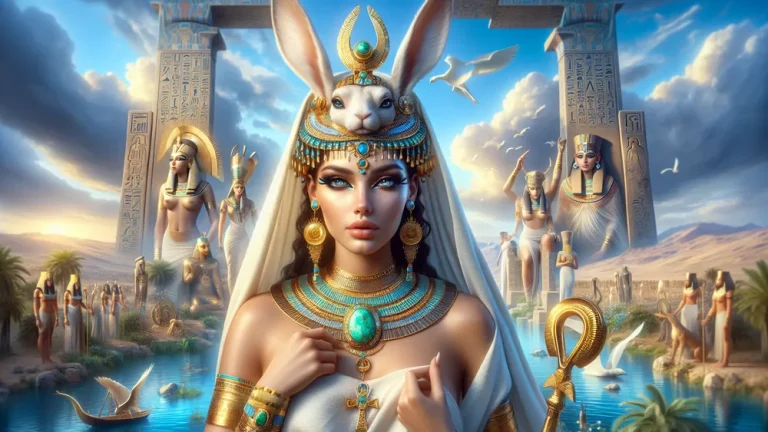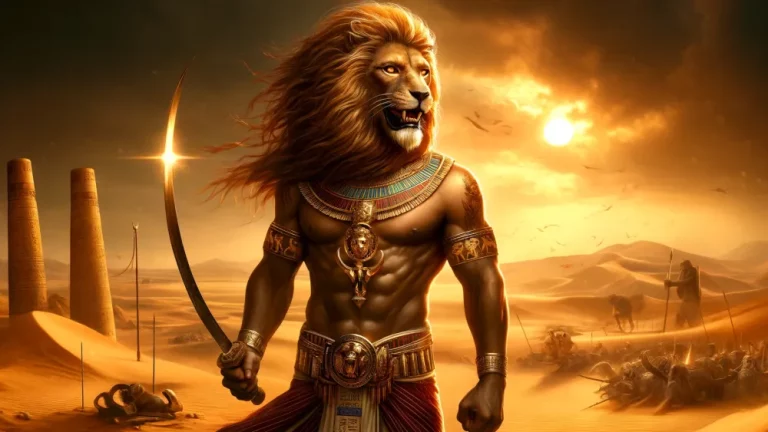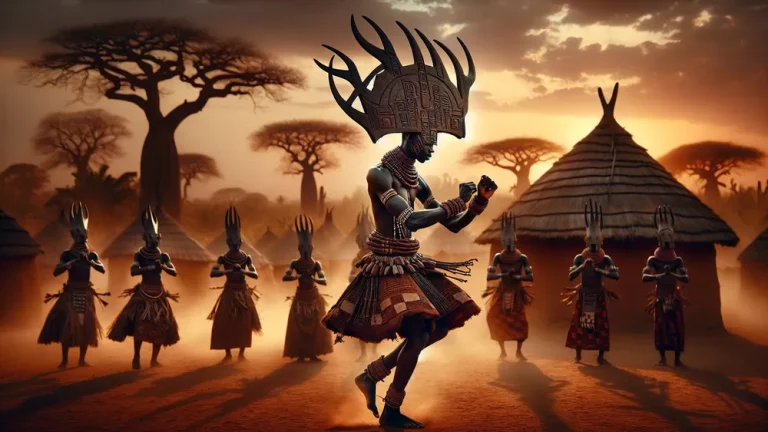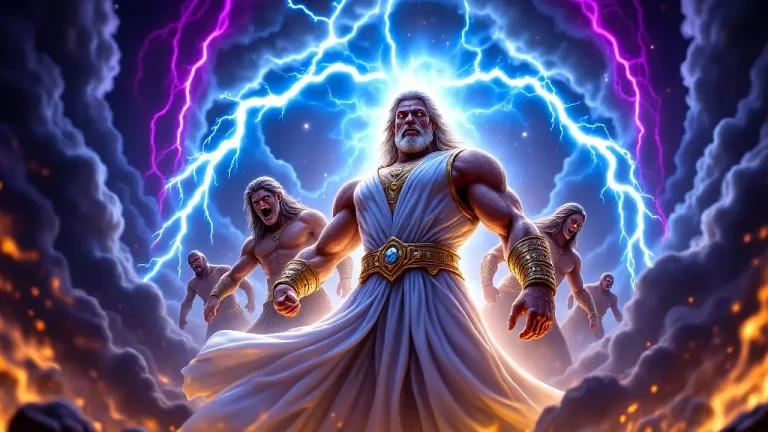Perses: Titan God Of Destruction In Greek Mythology
In the wide-ranging story of Greek mythology, Titans stand there as basic forces that mean many sides of the natural and cosmic order. Among these really old deities is Perses, who people know as the Titan god of destruction. Picture Perses like a big storm, a power that clears paths for new growth yet can also cause chaos afterward.
Key Points:
- Perses is the Titan god of destruction.
- He is the son of Crius and Eurybia.
- His siblings are Astraeus and Pallas.
- Perses is married to Asteria, and they have a daughter named Hecate.
- He played a role in the Titanomachy, siding with Titans against the Olympians.
- His name comes from the Greek word pertho, meaning to destroy.
- Perses symbolizes chaos and change in Greek mythology.
His being in mythology appears like a reason that brings change and transformation. As you start learning about Perses, you’ll see how his family, how he interacts, and what he symbolizes to explain his role as a sign of chaos.
This intro will help you understand Perses, making ready for a deeper jump into what he means mythologically and the lasting effects he has had on both old and new stories.
Perses: Overview and Key Facts
| Key Aspect | Details |
|---|---|
| Name | Perses |
| Role | Titan God of Destruction |
| Parentage | Son of Crius and Eurybia, which links him with the ancient gods of sea and space |
| Siblings | There are siblings who are Astraeus and Pallas, both big figures among the Titans |
| Partner | Asteria, who is a Titaness that connects with oracles and stars |
| Child | Hecate, who is the goddess of magic, witchcraft, and night |
| Symbols | Seen as a force of chaos and destruction, often understood as clearing paths for new beginnings |
| Battle Role | He took part in this big fight between Titans and Olympians, though less written about him when compared with other Titans |
| Cultural Impact | Not as much mentioned as others, but Perses’ influence lives on through Hecate and what he stands for as destructive power |
| Mentions in Texts | Named in works like Hesiod’s “Theogony” and other old Greek writings, which provide ideas about his role in mythology and family links |
The Beginnings of Perses
To really get what Perses is about and where he fits in Greek mythology, it’s important to look into his beginnings and family-related links, and these give the base for stories about him.
The Family Tree of Perses
To see where Perses fits in this group of Greek gods, it’s helpful to see his family line like a branching map that links him with other big gods. Son of Crius and Eurybia is who Perses is, putting him in the second batch of Titans. Crius, his father, one of the first Titans, and Eurybia, his mother, a child of Pontus and Gaia, connect Perses to old forces of sea and land.
There are siblings: Astraeus, with dusk and stars, and Pallas, who has warrior traits. These links point out his ties to sky and ground elements. And Perses’ marriage to Asteria, a Titaness that is linked to oracles and stars, further entwines his family line with the divine. Their child, Hecate, a strong goddess with magic and night. This family map not only slots Perses in the bigger Titan rank, but also links him to the natural and supernatural worlds. Here’s a short list to explain these links:
- Parents: Crius (Titan) and Eurybia (daughter of Pontus and Gaia)
- Siblings: Astraeus and Pallas
- Partner: Asteria
- Child: Hecate
Perses is a Titan connected to powerful forces of nature through his parents, siblings, and child, linking him to both the natural and supernatural realms.
Perses’ Connections with Other Titans
You can think of Perses‘ links with other Titans like the complicated layout of big family groups, where friends and rivals decide what each person does. Being Crius’ son means Perses is close to his siblings, Astraeus and Pallas, which makes a family tie that links him to sky and battle areas in the Titan world.

And his marriage to Asteria ties him even more to the gods, reaching into the prediction and star-related zones. These ties aren’t just about family but also about planning, because they put Perses into a network with other Titans that control different cosmic forces.
How he interacts with the other Titans, like possible friends or opponents during the Titanomachy, that points out his part as a force for breaking and changing. These ties explain how Perses’ family and other links shape his stories, placing him both as a family partner and a strong figure in the Titan group.
What Perses Did in the Titanomachy
After we looked at Perses’ family links and those with other Titans, our focus turns now to what he did in the big fight called the Titanomachy. It was these relationships that were important in what he did and who he was with in this battle.
How Perses Got Involved in the Titanomachy
In the big story of the Titanomachy, you might compare the war between Titans and Olympians to a chess game, where each Titan had a job to do, and Perses was no different. Perses was one of the second group of Titans and found himself caught up in this sky fight, driven by family loyalty and the overall fight for power.
It was his family line that mainly shaped his alliances because he stood with other Titans, like his father Crius and relatives, fighting the Olympian gods led by Zeus. The Titanomachy wasn’t just about strength but was also full of who was on whose side and strategies, with Perses using his skills to help the Titans.
What he did in the battles points out what he contributed, even though he’s not as famous as some relatives.

As the fight went on, the way battles turned changed, leading to the Titans losing. Even with their initial unity, they were beaten by the Olympians, who had better plans and godly weapons. Perses, like many Titans, was defeated, signaling the end of his role in the stories. This wasn’t just a personal loss for him; it was a big turning point, letting the Olympian gods take over. The Titanomachy is a key part of myth stories, which explains the shift of power from old gods to new ones. Here’s a short list to point out what Perses did:
- Alliances: Joined with Titans like his father Crius
- Role: Used his destruction skills for the Titans
- Fate: Lost with other Titans, marking the Olympians’ rise
Symbols and Traits of Perses
After we looked into Perses’ part in the Titanomachy, now, our focus moves to the symbols and traits that describe what he is like, which explains how these features hold his nature as a Titan of destruction.

Symbols and Traits of Perses
Perses is a Titan with traits like destruction, and he has characteristics similar to a wild storm, changing the regular way things happen and bringing chaos. His representation in Greek mythology as a sign of chaos isn’t just a story piece, but it means the wild powers that can shake things up.
While we don’t have many old pictures of Perses that lasted over time, you can often see his symbolic presence through his family line and his part in myth stories. The Greek word his name comes from, “pertho,” means “to destroy,” capturing his nature as a ruin force. This destructive trait isn’t just physical harm; it also means change, like how fire clears space for new plants to grow.
Understanding these symbols and traits, you can see how Perses fits in the bigger story of Greek mythos, as he stands for the needed chaos before new things and order happen.
Perses in Old Stories and His Cultural Impact
After we looked at the symbols and traits of Perses, his place in old stories, and then the importance he had in Greek mythology, we now go into.
Mentions in Hesiod’s Works
In Hesiod’s “Theogony,” Perses is named in the detailed web of Greek mythology, which is a link in the wide family network of gods and Titans. Like a family tree, his work provides an organized list of divine lines, and Perses stands out because of family ties more than exciting stories. Brief though this mention is, it is like a cameo in a film, hinting at a character’s deep meaning. Hesiod’s story tells us Perses is the child of Crius and Eurybia, which sets him among Titans’ second generation. He is married to Asteria; she makes his place firm in the myth structure, since they have Hecate, who is important in later myths. While not full of details, these hints help us see Perses’ spot in the Titan ranking and his side effect on later myth tales. Here’s a simple list of his mentions:

- Parentage: Son of Crius and Eurybia
- Marriage: Husband to Asteria
- Offspring: Father of Hecate
Perses in Rituals and Worship
In old Greek worship and rituals, even with his strong link to destruction, Perses is not seen as the main point for any big temples or well-known cult activities. Unlike important gods and goddesses, who had large temples, he had no main temples.
Without any big celebrations for him, Perses’ role in religious practices was quiet, much like a background part in a big stage play. This lack of direct worship is linked to his sign of chaos and destruction, which were not usually celebrated the same as kind parts of the divine.
However, maybe his presence figured indirectly through rites tied to his daughter, Hecate, who was respected in many rituals, especially those that kept bad things away. During such times, you see how Perses fits in the wider old Greek religious scene, as a sign of the destructive things that were a key part of cosmic balance.

Perses, though connected to chaos and destruction, lacked major temples or celebrations in ancient Greek worship, mostly being recognized indirectly through rituals honoring his daughter, Hecate.
Comparing Perses to Other Titans
After looking at Perses’ job in old rituals and his quiet place in Greek worship, now, we’ll see how he matches up with other Titans in features and importance.
Comparing Perses to Other Titans
In the large group of Greek Titans, each figure has a unique job, like parts in a big story, each one helping in a unique way to the main story. Known mainly for destruction, Perses is compared to Titans like Hyperion, who stands for sunlight.
While his job is seen as giving life and bright, Perses means the darker, more chaotic parts of the universe. This balance means creation and destruction are opposites found in many stories. Titans like Oceanus, who stands for the huge river around the earth, show different jobs in the Titan ranking. His area is wide and gives life, compared sharply with Perses’ focused, destructive side.
The table means you see where Perses stands beside other Titans:
| Titan | Job/Area | Main Features | Meaning in Stories |
|---|---|---|---|
| Perses | Destruction | Chaos, Destructive Force | Dark parts of the universe |
| Hyperion | Sun/Light | Brightness, Life-giving | Stands for sky light |
| Oceanus | Ocean/Water | Wide, Life-giving | Stands for surrounding river |
| Cronus | Time/Tools | Leadership, Authority | Titan leader, father of Zeus |
| Rhea | Motherhood/Pregnancy | Caring, Protective | Mother of the main gods |
So, you see how each Titan’s features and areas mean different jobs in Greek mythology, making it clear where Perses fits in this complex story.
How Perses Fits into Greek Cosmology
After looking at Perses and the Titans, now let’s see how his traits and what he does fit into the wider setup of the Greek universe.

How Perses Fits into Greek Cosmology
In Greek cosmology, Perses has a spot that highlights the balance between creation and destruction – a basic idea in how Greeks saw the universe. Think of the universe as a big band where each part, even small, plays an important role in the whole. Perses, acting as the forces of chaos and change, means the needed steps for change and new things.
This idea is the same as life and death cycles, where old things make way for new starts. In Greek views, these forces didn’t just appear as bad but were essential parts of the cosmic plan. By acting like this, Perses goes with the creative forces of other gods, keeping the universe in a moving balance.
In this way, it shows Greeks’ smart view about how everything connects, where even chaotic bits have their right spot in the universe plan.
The Lasting Impact of Perses in Greek Mythology
After we looked at Perses‘ role in the universe, we turn now to see how his effect has spread into later myths and reaches into modern meanings.
How Perses Influenced Later Myth Stories
Perses as a form of destruction and chaos has put a lasting effect on later myth stories, acting as a source for ideas about change and big changes. Perses is like a storm that seems destructive first but clears the way for new things. In myths, this idea is copied where characters go through big trials or changes, often caused by things they cannot control.
For example, the story of Heracles, who faces many challenges testing his strength, appears like it draws from the wild energy that Perses means. Likewise, the story of the Phoenix, a bird that comes back from ashes, copies the idea of destruction bringing new life, a theme in Perses’ effect. By being the needed chaos before new start, the legacy of Perses stays in stories that mean the life cycle and power of changes.
Perses in Modern Times
In modern times, Perses has been put in different media, often acting as a sign of change that matches modern themes. Imagine Perses as a character in a story or movie who represents the chaos needed for a main character’s growth, like a storm that makes characters face fears and grow stronger.
In literature, authors, using Perses’ old myth roots, often look at stories of change and big changes. Using his model to add depth, these stories become richer. Even in visual arts, Perses gets shown to point out the beauty and need for destruction before new things happen, reflecting his old role.
In popular things like video games or graph novels, Perses can appear as a strong thing pushing heroes to change and win, reflecting his lasting part as a sign of change. Through these new ideas, Perses still interests people, linking old and modern worlds with his unchanging ideas.
Perses appears in various modern media as a symbol of transformation, representing the chaos essential for characters to confront fears and grow.
Pantheon of Greek Titans
Often people see the Greek Titans as basic forces of the world; they form a big and interesting group that comes before the more known Olympian gods. Think of them as roots of a huge myth tree, each one helping the base and growth of Greek stories.
These old gods, like Cronus, Rhea, and Oceanus, in other words, show different parts of the natural world. They appear big and grand, being the raw parts of nature and order of the whole world. For people wanting to see the full names and roles, there’s a whole view of all their names available here.
This group not only makes way for the Olympian gods but also lets us see the old Greeks’ view on space and their part in it.
FAQs
1. Who were the parents of Perses?
The parents of Perses were the Titan Crius and the goddess Eurybia.
2. What powers did Perses possess?
The powers Perses possessed were primarily associated with destruction and chaos, reflecting his role as a Titan god of destruction in Greek mythology.
3. How is Perses depicted in ancient art?
How Perses is depicted in ancient art is largely speculative, as there are no surviving artworks definitively identified as representing him.
4. What is the significance of Perses’ name?
The significance of Perses’ name lies in its etymology, which is derived from the Greek word “pertho,” meaning “to destroy,” reflecting his mythological role as the Titan god of destruction.







